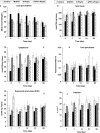Phytic Acid Exposure Alters AflatoxinB1-induced Reproductive and Oxidative Toxicity in Albino Rats (Rattus norvegicus)
- PMID: 18955247
- PMCID: PMC2722202
- DOI: 10.1093/ecam/nem137
Phytic Acid Exposure Alters AflatoxinB1-induced Reproductive and Oxidative Toxicity in Albino Rats (Rattus norvegicus)
Abstract
The increased use of feed in Egypt's aquaculture and animal industries raises concerns about the possible presence of mycotoxins in feedstuffs. The use of alternative medicine, such as botanicals and nutritional supplements, has become popular with inflammatory cases. The present study aimed to testify the role played by phytic acid (IP6) in enhancing the reproductive and oxidative toxicity induced in aflatoxinB1 (AFB1) treated white male albino rats (Rattus norvegicus) throughout treatment and withdrawal periods. One hundred and twenty white male albino rats were grouped into four groups. Group 1, was injected with 300 mug kg(-1) body wt of AFB1 once every 3 days for 15 days and left uninjected for another 15 days to study the withdrawal effect. Group 2, was injected with 300 mug kg(-1) body wt of AFB1 once every 3 days for 15 days and treated simultaneously with IP6 daily for another 15 days. Group 3, was treated daily with IP6 (40 mg kg(-1) body wt) for 15 days and with no treatment for other 15 days. Group 4, injected with equivalent volume of sterile phosphate buffer saline solution as a control group. Sera were taken at the experimental intervals and assayed for testosterone hormone, follicular-stimulating hormone (FSH) and luteinizing hormone (LH) to determine the toxicological impact of AFB1 and the possibility of amelioration by phytic acid on the reproductive performance of the studied animal. The effects of AFB1 treatment on the absolute and relative weight of testis as well as its histopathologic effect on the testis and the possibility of amelioration by IP6 treatment were evaluated. The activities of enzymatic and non-enzymatic anti-oxidants, in addition to lipid peroxidation were measured in the testis' homogenate of AFB1-treated rats. A decrease in sex hormone levels, an increase in testicular lipid peroxidation product levels and a significant decrease in testicular glutathione content, catalase and total peroxidase and superoxide dismutase activities were recorded. The histopathologic alterations revealed a degeneration and highly mitotic division within the spermatogenic nuclei, in addition to some karyomegaly and nuclear pyknosis. It is concluded that the reduction in the toxicity of free radicals by phytic acid might be responsible for the protective influence observed.
Keywords: aflatoxicosis; histopathology; hormonal assay; rats.
Figures










Similar articles
-
Dietary aflatoxin B1 and antimalarial-a lumefantrine/artesunate-therapy perturbs male rat reproductive function via pro-inflammatory and oxidative mechanisms.Sci Rep. 2023 Jul 27;13(1):12172. doi: 10.1038/s41598-023-39455-1. Sci Rep. 2023. PMID: 37500724 Free PMC article.
-
NTP technical report on the toxicity studies of Dibutyl Phthalate (CAS No. 84-74-2) Administered in Feed to F344/N Rats and B6C3F1 Mice.Toxic Rep Ser. 1995 Apr;30:1-G5. Toxic Rep Ser. 1995. PMID: 12209194
-
Immunomodulating effect of inositol hexaphosphate against Aeromonas hydrophila-endotoxin.Immunobiology. 2007;212(3):179-92. doi: 10.1016/j.imbio.2007.01.006. Epub 2007 Mar 6. Immunobiology. 2007. PMID: 17412285
-
Influence of vitamin E and quercetin on Nigerian Bonny Light crude oil-induced neuronal and testicular toxicity in Wistar rats.J Basic Clin Physiol Pharmacol. 2015 May;26(3):223-31. doi: 10.1515/jbcpp-2013-0043. J Basic Clin Physiol Pharmacol. 2015. PMID: 25046308
-
Effect of selenium on carbimazole-induced testicular damage and oxidative stress in albino rats.J Trace Elem Med Biol. 2011 Jan;25(1):59-66. doi: 10.1016/j.jtemb.2010.07.002. Epub 2010 Sep 15. J Trace Elem Med Biol. 2011. PMID: 20832273
Cited by
-
Camel milk or silymarin could improve the negative effects that experimentally produced by aflatoxin B1 on rat's male reproductive system.BMC Vet Res. 2024 Mar 18;20(1):108. doi: 10.1186/s12917-024-03965-5. BMC Vet Res. 2024. PMID: 38500117 Free PMC article.
-
Effects on Steroid 5-Alpha Reductase Gene Expression of Thai Rice Bran Extracts and Molecular Dynamics Study on SRD5A2.Biology (Basel). 2021 Apr 11;10(4):319. doi: 10.3390/biology10040319. Biology (Basel). 2021. PMID: 33920399 Free PMC article.
-
Hordeum vulgare L. microgreen mitigates reproductive dysfunction and oxidative stress in streptozotocin-induced diabetes and aflatoxicosis in male rats.Food Sci Nutr. 2022 Jul 7;10(10):3355-3367. doi: 10.1002/fsn3.2936. eCollection 2022 Oct. Food Sci Nutr. 2022. PMID: 36249986 Free PMC article.
-
Early Life Exposure to Aflatoxin B1 in Rats: Alterations in Lipids, Hormones, and DNA Methylation among the Offspring.Int J Environ Res Public Health. 2021 Jan 12;18(2):589. doi: 10.3390/ijerph18020589. Int J Environ Res Public Health. 2021. PMID: 33445757 Free PMC article.
-
Phytic acid decreases deoxynivalenol and fumonisin B1-induced changes on swine jejunal explants.Toxicol Rep. 2014 May 29;1:284-292. doi: 10.1016/j.toxrep.2014.05.001. eCollection 2014. Toxicol Rep. 2014. PMID: 28962245 Free PMC article.
References
-
- Sharlin J, Howarth B, Thompson F, Wyatt R. Decreased reproductive potential and reduced feed consumption in mature white leghorn males fed aflatoxin. Poultry Sci. 1981;60:2701–8. - PubMed
-
- Hafez A, Megalla S, Abdel-Fattah HM, Kamel YY. Aflatoxin and aflatoxicosis. II. Effects of aflatoxin on ovaries and testicles in mature domestic fowls. Mycopathologia. 1982;77:137–9. - PubMed
-
- Jantrarotai W, Lovell R. Subchronic toxicity of dietary aflatoxin B1 to channel catfish. J. Aquatic Animal Health. 1990;2:248–54.
-
- Abou El, Magd M. Zagazig, Egypt: Pharmacology, Forensic Medicine and Toxicology Dept. Fac. Vet. Med. Zagazig Univer; 1996. Immunotoxicological studies on the effect of aflatoxin in O. niloticus. PhD Thesis.
-
- Luyendy K, Copple B, Barton C, Ganey P, Roth R. Augmentation of aflatoxinB1 hepatotoxicity by endotoxin: involvement of endothelium and the coagulation system. Tox Sci. 2003;72:171–81. - PubMed
LinkOut - more resources
Full Text Sources

